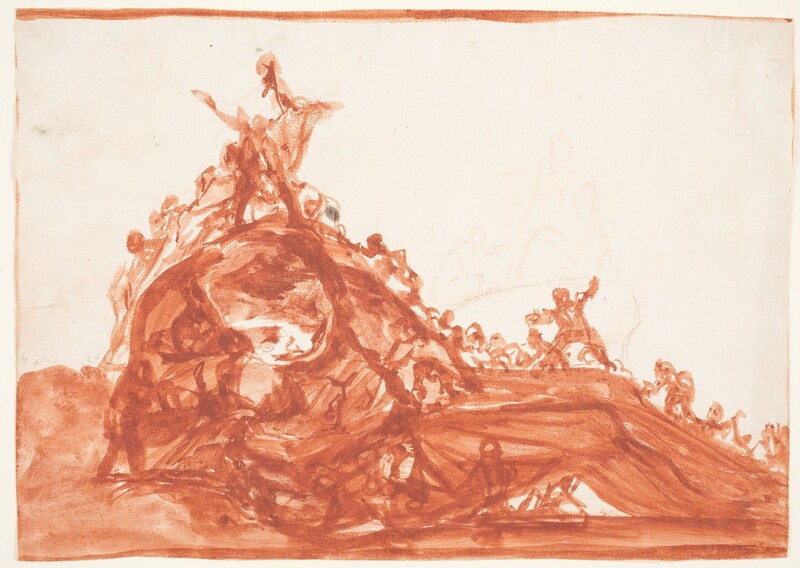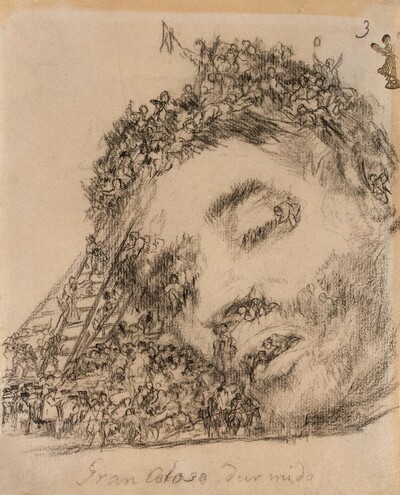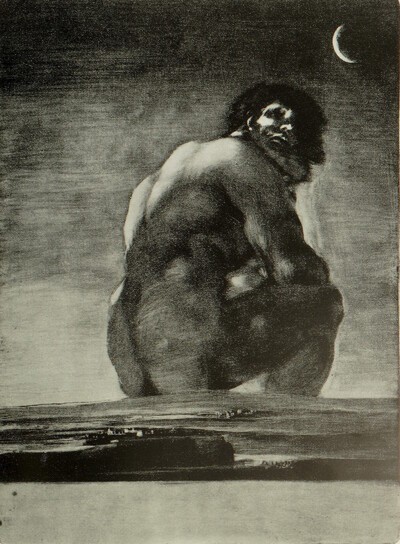- Cronología
- 1816 - 1819
- Ubicación
- The Prado National Museum. Madrid, Madrid, Spain
- Dimensiones
- 234 x 330 mm
- Técnica y soporte
- Reconocimiento de la autoría de Goya
- Documented work
- Titular
- El Prado National Museum
- Ficha: realización/revisión
- 19 Aug 2021 / 08 Jun 2023
- Inventario
- D4287
4 (in pencil, recto, left margin)
201 [inscribed in oval] (in pencil, verso)
not engraved? [under adhesive] (in pencil, verso, upper left)
MP Inventory Inventory DRAWINGS Goya (stamped, verso, upper right corner)
Watermark: "MANUEL SERRA" (half right)
The drawing was inherited in 1828 by Javier Goya, the painter's son, and in 1854 by Mariano Goya y Goicoechea, the artist's grandson. It was subsequently owned by Valentín Carderera (ca. 1861) and Mariano Carderera (ca. 1880). In 1886 it was acquired from Mariano Carderera by the Directorate General of Public Instruction and was assigned to the Prado Museum, where it entered on 12 November 1886.
See People in sacks.
Drawing traditionally ascribed to the series of preparatory drawings for the Disparates, on the basis of its technical and compositional similarity and the paper used. However, it does not correspond to any of the prints in the engraved series.
A gigantic figure lies across the composition, leaning against a rise in the ground. A multitude of tiny figures have taken it for a hill. They use a ladder to climb up its back and climb up its legs. One of these tiny creatures stands on its crown, with an air of victory. There is a regret in the preliminary drawing, executed in sanguine, above the colossus's knees, as if Goya had depicted him with his legs more bent, on which the faint outlines of other tiny figures can be seen.
The giant prisoner's face is brightly lit and, despite his situation, he wears a malicious smile. This feature distinguishes it from other tormented depictions of giants and giants in Goya's works on paper, which he used on several occasions. This is the case of the drawing Great Sleeping Colossus or the aquatint The Colossus. Pierre Gassier alludes to a recurring reference: the story of the country of Lilliput narrated in Jonathan Swift's Gulliver's Travels (1726).
-
Bern
-
Madrid1999
-
GoyaGalleria Nazionale d’Arte Antica di Palazzo BarberiniRoma2000consultant editors Lorenza Mochi Onori and Claudio Strinati. From March 18th to June 18th 2000cat. 54
-
París2001
-
Madrid1928p.31, cat.201
-
1951pp. 50-51
-
Los dibujos de Goya, 2 vols.MadridAmigos del Museo del Prado1954cat. 397
-
OxfordBruno Cassirer1964vol. II, p. 414, cat. 269g
-
Vie et ouvre de Francisco de GoyaParísOffice du livre1970p. 327, cat. 1611
-
Dibujos de Goya, 2 volsBarcelonaNoguer1975pp. 470-471, cat. 309
-
Roma Edizioni de Luca2000pp. 148-149, cat. 54


